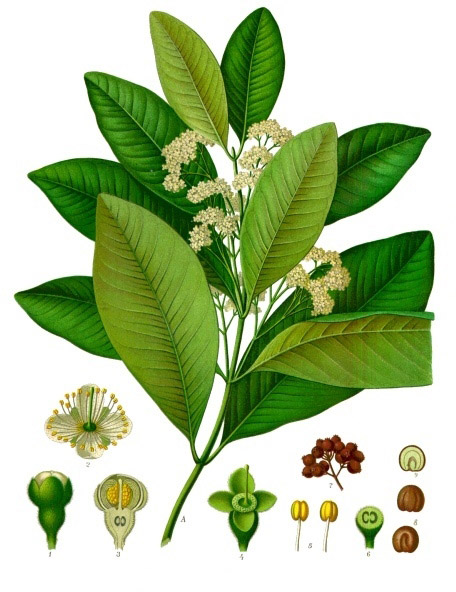Allspice

Pimenta dioica - tree from which Allspice berries are harvested.
Illustration: Köhler's Medizinal-Pflanzen. 1897. (PD)
Allspice - Botany And History
Allspice is a relatively popular culinary spice with somewhat considerably antiquated origins and is considered among the earliest spices that were sought-after by Conquistadors. Allspice was very common spice by the mid-1600s, and is among the most frequently employed, highly traded, and commonly mentioned New World culinary spices. Termed 'all-spice' by the English traders of the age due to the belief that it was a medley of the flavours of their major culinary spices - cinnamon, cloves, and nutmeg, it soon became a popular alternative to those three distinct spices, especially for the early settlers in the New World who wanted to perpetuate their own cultural culinary 'signature' without the need to spend what was then exorbitant prices for the purchase of 'Oriental'-based spices.
Well into the height of the Colonial Period, allspice was largely cultivated, harvested, and processed as commodity goods shipped to mainland Britain from the colonies where the plant grew in profusion, making it a then prized and much-employed plant, albeit costing only a fraction compared to spices which were imported from the Far East. Within the Colonies-proper, it was itself used regularly, often as an alternative to costlier spices, or as a stand-alone spice on its own right, generally for culinary uses, but later on, for medicinal employment as well.
Allspice is derived from the Pimenta dioica tree, a mid-canopy evergreen species that is considered a native of areas such as Central America, Mexico and the Greater Antilles. The Pimenta dioica tree, which grows to a minimum of twenty-two feet and a maximum of forty-three feet in length if left to its own devices, is characterised by its dark-green, broad, emerald-green, semi-glossy to matte leaves that possess a characteristically tough texture redolent of bay leaves. It is discernable for the profusion of tiny, ivory-white to carnation-hued florets that stem from the middle of the leafy growths, and for its large, dark-green fruits, from which allspice is derived. [1]
The fruit of the Pimenta dioica is more often than not harvested prior to ripening, when the fruit is mature enough to be of moderate size (several centimetres larges than a regular peppercorn), but still immature as to be considered unripe. The plant is chiefly cultivated for its fruits, although the leaves can and has been used as a spice in its own right, generally as a substitute for bay leaves. The fruit is employed only in its dried form, and is sundried in the traditional method of processing. Allspice can be used in whole form (akin to the employment of peppercorns), although partially ground and finely powdered types are also available in retail stores. The leaves are often employed fresh; as it loses much of its flavour and aroma once it is dried. Because of this, allspice leaves are generally found and used only where the plant grows in profusion, or where ready access to fresh specimens are available. In some instances, the leaves may be dried, ground, and mixed with powdered allspice berries as a bulking agent, or otherwise mixed along with whole berries in its un-ground, dried form, albeit only rarely. Allspice is a commonplace spice employed in a number of various cuisines, not solely restricted to European and American cookery, but found in a number of cuisines such as that of the Chinese, African, Indian, and Italian. It must be noted that allspice is used mainly as a substitute spice, and as such is typically favoured by the diasporas of the above-stated cultures, either due to the inaccessibility of spices commonly favoured by their respective cuisines, or due to the cheaper, but nearly similar flavour profile of the spice in contrast to the respective spices (i. e. cinnamon, nutmeg, cloves, bay) favoured by such cultures. [2]
Allspice has been traded and employed since the mid-1600s, but had not reached its utmost popularity until later. Its usage spread from the New World into Middle Eastern cuisine, and has become near indespensible to some type of Levantine, Arabian, Moroccan, and Palestinian recipes. Today, it is a very commonplace spice, although the number of culinary styles that favour its use remains somewhat limited. It is highly favoured in Caribbean, Creole, and Cajun cuisine, while it features moderate in Traditional Chinese Medicine and Southern folkloric medicine. It was initially 'discovered' by Christopher Columbus on the island of Jamaica during his second voyage to the New World, although the spice itself was probably already known to intrepid mariners and explorers prior to Columbus. The name allspice (then referred to as 'pimento') was coined by a fellow voyager, a doctor by the name of Diego Alvarez Chanca, who was also the first individual to study and posit its medicinal effects to the European populace at large upon its general introduction to Western cuisine. [3]

Allspice - Herbal Uses
Allspice is a highly versatile spice that is employed by a number of different cuisines, generally as a substitute for cloves, cinnamon, nutmeg, and bay leaves. The dried berry, employed either in whole, partly-ground, or powdered form is a frequent addition to a number of meat-based dishes. It is generally used as an additive to gamey meats, beef, and even poultry, while some cuisines opt to add it a select number of seafood-based or vegetable-and-meat-based dishes. It plays an integral role in Middle Eastern and Mediterranean cuisine, while it is favoured over spices typical spices (i. e. cloves, nutmeg, and cardamom) in a number of American folk cookery. It has become a major ingredient in chilies, and can even be employed for pickling and flavouring desserts. Allspice has even been used as a condiment and additive to sundry foodstuffs, such as sauces, dips and spreads. German and Pennsylvania-Dutch cookery often employ allspice as a powerful preservative agent and flavour enhancer in the creation of their famed sausages and other preserved meats. [4]
Aside from the dried berries, the leaves of allspice is also employed in cookery, but due to the volatile nature of the leaves its usage is only limited in fresh form, typically in areas where there is a readily viable access to fresh leaves. It is often used as an additive to soups, stews, and chowders in lieu of bay leaves or bay laurel, although it's most popular usages seems to be in smoking meats and other delicacies, generally done in tandem with the aromatic wood of the plant itself, and often with the accompaniment of a limited amount of berries. [5]
The wood of the tree possesses a beautiful hue and grain if properly dried and crafted, and has been employed as a smoking agent. It has also been used in artwork, and was once crafted into small objets d'art, or otherwise employed in the creation of walking canes, sword handles, firearm butts, and a number of other artisanal items, chiefly because of its aromatic nature which continues to exude a subtle, pleasant nuance long after it has been cut, and also due to its beauty and durability.
Aside from its culinary uses, allspice was a highly popular medicinal herb, with a number of viable applications. During the Age of Discovery, it was often employed by voyagers and seafarers as a local topical antiseptic, often strongly decocted or otherwise allowed to steep in alcoholic beverages, however this practice did not become commonplace until much later (circa 1700s). In a general sense, allspice is considered by Western alternative medicine as possessing digestif, carminative, analgesic, antiseptic, anti-inflammatory, antioxidant, and antimicrobial properties. When mildly decocted and drunk as a tea, it can be given prior to and after meals to act as a digestif and to prevent indigestion, bloating, and dyspepsia. In some cultures, it is generally drunk as an after-meal or pre-meal beverage (much like cinnamon or cloves) in the belief that it aided digestion and improved the body's capacity to synthesise the nutrients derived from food. Milder decoctions of the dried berries (sometimes combined with the leaves) may be drunk as a remedy for flu, colds, fever, coughing, and menstrual problems as it also possesses antipyretic, expectorant, and emmenagogue properties. [5] Allspice is an antioxidant rich spice, and regular and moderate incorporation to sundry foodstuffs may help to boost the body's immune system to fight against free-radicals, as well as certain types of degenerative diseases.
Strong decoctions of whole allspice berries may even be applied topically as an antiseptic rinse to help disinfect wounds and hasten the healing of minor topical injuries. Allspice, like cloves, is a potent antimicrobial and antifungal agent and may be employed to remedy minor to moderate skin allergies when applied topically. [6] When used as a hair rinse, very potent decoctions of the dried berries and even the fresh leaves of allspice helps to treat problems such as dandruff, eczema, psoriasis, and severe oiliness brought about by excessive sebum production. Used as a gargle, it can be employed to alleviate the pain of mouth sores or cold sores, to treat halitosis, to improve the strength of the gums and remedy gingivitis, as well as to prevent the formation of plaque and the accumulation of bacteria on the teeth (it is in fact due to these distinct properties that allspice is often incorporated as an additive to organic-based toothpastes).

Powdered allspice can in fact be used as an alternative to toothpaste, especially if combined with powdered potassium alum and finely powdered basil or thyme leaves. This organic toothpaste powder can be liberally added to one's toothbrush and employed while dry in lieu of toothpaste, or otherwise gently wet to form a slightly thick paste and used as one would regular toothpaste (although this natural approach does not result in the well-known lather found in conventional synthetic toothpastes). [7] Powdered allspice may also be used as a styptic for minor wounds and scratches, although due to its potent antiseptic nature, the application may leave a stinging or burning sensation on the skin. When allowed to infuse in a base oil of one's choosing (in either its whole or ground form), it can even be employed as a topical analgesic for pain management, especially if combined with other analgesic spices such as ginger root. It not only helps to alleviate the symptoms of rheumatism and arthritis, but it may also help to improve one's circulation and remedy problems such as cold extremities (i. e. hands or feet) and even gout. [8]
By the 17th and 18th centuries, allspice tinctures and 'waters' became in vogue, with recipes for the creation of a number of therapeutic eau de toilettes becoming quite common, although due to the pricey nature of some spices or herbs incorporated into its creation, it was typically only common fare for the middle classes bourgeoisie, the gentry, and the aristocracy at large. [9] Tincture of allspice, and allspice water (or 'pimiento water') as it was known, were often made in perfumeries and select apothecaries, and were sold as both a type of personal scent, and as a medicated therapeutic substance.
The essential oil of allspice is likewise a very potent analgesic and antimicrobial agent, although due to its potency, it is only employed in a highly diluted state or otherwise used very sparingly. Allspice essential oil (diluted with one's choice of base oil), can be useful for the treatment of a number of different fungal and topical bacterial infections, but because it can be toxic when used in large amounts, it can only be applied topically for a limited time. [10]
Allspice - Esoteric Uses
Allspice is also a very popular herb for people who dabble in the occult. It is generally employed in voodoo and hoodoo as a money-attracting herb, generally when encased in a medicine pouch or juju bag alongside other luck-enhancing herbs. When the whole leaf and berries are burnt as incense, it can be employed to help attract wealth and luck to an establishment, and is an excellent choice for consecrating and blessing incense for new businesses. When employed on a sickbed, it is believed that allspice incense can help to drive away illness and hasten the recovery of a patient. Because it is similar to cloves to some extent, it can even be employed as an herb of protection in some cases, and may help to drive away evil entities. The range and scope of allspice's occultic uses are limited generally because of the fact that it is a decidedly 'new' spice, when compared to other, more 'ancient' spices, although they are often integrated into a number of incense mixes and potion recipes in the belief that it enhanced the overall effect of such spellworkings. [11]
Allspice - Contraindications And Safety
While allspice is safe when consumed in small to moderate amounts, either as a culinary spice or as a condiment, the medicinal usage of allspice should be limited to minute to very moderate amounts, as excessive consumption of allspice can be detrimental to a person's health. An overdose of allspice, regardless of the method of absorption, can result in side-effects such as nausea, and vomiting. In severe cases, depression, convulsions, and even death can result from an overdose of allspice. Recent studies have also reported that one of the active compounds of allspice - the essential oil eugeol - can be a minor carcinogenic, hence the need to limit the intake of allspice, or to avoid prolonged usage and consumption. Due to the highly potent nature of allspice, pregnant and nursing women should discontinue the usage and consumption of any products or preparations which contain it, as it may cause miscarriages and possible complications during the interim of one's pregnancy or during nursing. The topical application of allspice may also result in allergic reactions, especially for individuals with highly sensitive skin, so patch-testing prior to usage should always be considered standard protocol. It should be noted that individuals who have diseases such as stomach ulcers and other gastrointestinal problems should likewise limit or even discontinue the usage and consumption of allspice, as it may aggravate the disease.
Allspice - Other Names, Past and Present
Chinese: duo xiang guo
Korean: pimang
Hindi: seetful
Arabic: kabab cheene
French: piment de la Jamaique / poivre Anglais / poivre aromatique / poivre de Jamaique / poivre de la Jamaique / quatre-epices / toute-epice
Spanish: pimento / pimienta de Jamaica
Italian: pimienta
German: Jamikapfefer
English: clove pepper / Jamaica pepper / Spanish pimienta / west pimienta / allspice / newspice / myrtle pepper / pimento (adapted from Spanish, should not be confused with the chili pepper variety called pimienta or pimiento) [note: other plants are often referred to as 'allspice', but Pimienta dioica alone is considered 'authentic' allspice]
Latin (scientific nomenclature): Pimienta dioica
References:
[1][2][3] https://en.wikipedia.org/wiki/Allspice
[4-5] https://www.kew.org/science-conservation/plants-fungi/pimenta-dioica-allspice
[6] https://www.nutrition-and-you.com/allspice.html
[8] https://www.livestrong.com/article/408917-what-are-the-health-benefits-of-allspice/
[9] https://www.anniesremedy.com/herb_detail1.php
Main article researched and created by Alexander Leonhardt.
© herbshealthhappiness.com



1. Famous Chef Sheds 60lbs Researching New Paleo Recipes: Get The Cookbook FREE Here
2. #1 muscle that eliminates joint and back pain, anxiety and looking fat
3. Drink THIS first thing in the morning (3 major benefits)
4. [PROOF] Reverse Diabetes with a "Pancreas Jumpstart"
5. Why Some People LOOK Fat that Aren't
6. Amazing Secret Techniques To Protect Your Home From Thieves, Looters And Thugs
7. The #1 WORST food that CAUSES Faster Aging (beware -- Are you eating this?)
If you enjoyed this page:






























